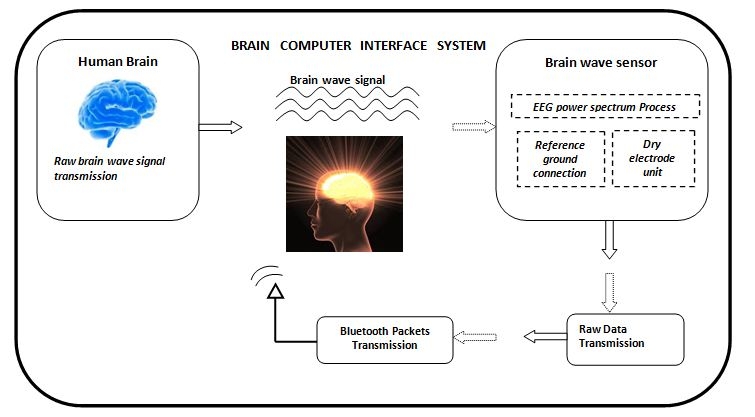Brain Computer Interface (BCI) is the direct connection between the computers and human brain. The BCI reads the waves produced from the brain at different locations in the human head, translates these signals into actions and commands ,that can control the computers. We propose to integrate this technology with home automation. This interface system is especially useful for severely disabled or locked-in individual with no reliable muscular control over their body parts to interact with surrounded peripherals. The system involves two parts: an EEG sensor circuit and a Arduino microcontroller board. The brain waves are captured using electrodes. These signals are filtered and amplified to remove noise .These analog signal is converted to digital. The digital signals are decoded and are used to switch on a device. Key Words: Brain computer interface, Automation, EEG, Arduino, Brainwaves
Amazingly, nothing in the world can be compared with the human brain. Our Human Brain is highly complex and is made up of about 100 billion neurons. There are many types of neurons in our brain such as motor neurons, sensory neurons. These neurons get fired up while generating a response for a particular stimulus and generate an electrical signal. These electrical signals are not fully transferred from one neuron to another, but some part of it escapes and reaches the scalp. These signals are captured by the electrodes and used to control the device. Home Automation is an area where BCI can be used and our entire house can be controlled simply by our brain. BCI is a direct communication pathway between an enhanced or wired brain and an external device. Braincomputer interface can be classified into three main groups-invasive, semiinvasive and non- invasive. In invasive BCI systems, the EEG sensing device are directly placed on human brain through critical surgery. In semi-invasive BCI system, the EEG sensing device is placed on our skull, directly on top of human brain. In non-invasive BCI system, the EEG sensing device are placed outside our brain and is considered by far the most practical safest BCI system. We have proposed a home automation system using BCI in this paper. Using this technology the life of people would be further simplified, physical efforts would be considerably reduced and it would also prove as a boon for physically disabled people.
It has basically an EEG sensor circuit and a microcontroller.EEG signal is acquired using electrodes. Our system uses 3 electrode scheme. The electrodes are placed in 3 forehead position. The EEG signal is filtered and amplified using amplifiers .The filtered and amplified signal is fed to a microcontroller (Nano board).The microcontroller converts the analog signal to digital signal. The components used in our hardware are:
We will be using dry non-invasive AgCl disposable clinical electrode. We are using three electrode scheme. These three electrodes are placed in three particular positions in our forehead where we will obtain the electrical signals associated with our eyes.
The AD8232 is an integrated signal conditioning block for ECG and other bio potential measurement applications. It is designed to extract, amplify, and filter small bio potential signals in the presence of noisy conditions. This design allows for an ultra low power analog-to-digital converter or an embedded micro controller to acquire the output signal easily. The AD8232 can implement a two-pole high-pass filter for eliminating motion artifacts and the electrode half-cell potential. This filter is tightly coupled with the instrumentation architecture of the amplifier to allow both large gain and high-pass filtering in a single stage.
We use ARDUINO UNO board for it’s feasibility and simplicity. It employs ATMEGA328 microcontroller. It is programmed in embedded C using Arduino IDE. The Arduino will do the following operations:
- Will take the analog signal data from the ICAD8238 and process it according to the working specified.
- The Arduino will send the control signal to the device that is to be controlled.
Our BCI system captures the electrical signals from the forehead position. The electrodes will then send the signals to the amplifier and filter circuit wherein the signal is amplified and unwanted noise and signals are filtered out .The analog signals are then converted into digital signals by the inbuilt ADC of Arduino. Since the electrical signals are taken from the forehead position near the eyes, they contain data regarding the eye movement. Thus we obtain the eye blink count from the obtained electrical signal .The micro controller process the signals based on the following logic:
- Whenever we blink, EEG waves will encounter a peak.
- This peak value is set as threshold value.
- If we blink, the output of the ADC goes beyond the threshold value, the Arduino counts it as a blink.
- The moment we blink, the timer of the microcontroller will start.
- If we blink a certain number of times in a certain interval of time, the micro controller will enable the relay switches.
- Depending on which relay switch is provided with the control signal, the respective device turn on.
- The number of blinks and the interval can be decided by the user. As an example, if we blink 2 times in 9 seconds then the relay one will get the control signal and the device which is connected to relay 1 will operate. The above logic can also be implemented using machine learning, which will greatly reduce the error of the system. Fig -3: Hardware
It is quite probable that in the future most of our appliances will be controlled directly through our wishes or the brain and this project stands as an affirmation to that vision. Signals from the brain can be further studied and the technology can be refined to bring about more specific results. The scope of the project was primarily to establish control through no physical motion on part of the user and it has been successful in doing so but it has also laid a foundation for many applications
